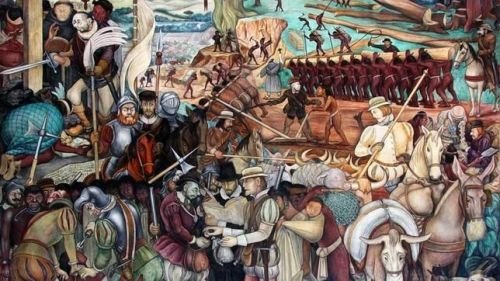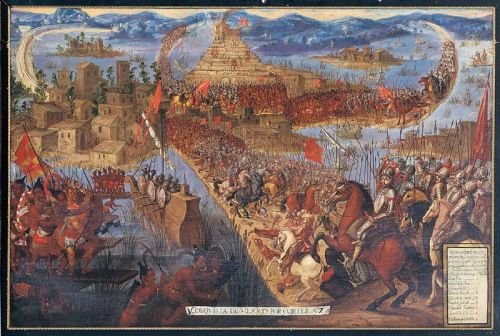Conquest of America: What is it, Characteristics and Meanings
Conquest of America
What is the Conquest of America
The conquest of America is known as the process of invasion, domination and expansion that certain European nations exercised in the American continent from the discovery that occurred in 1492.
The conquest of America began in the 16th century at the hands of Spain, which was closely followed by Portugal. From the seventeenth century, England, France (although it had already made a presence in the sixteenth century) and Holland joined.
In its beginnings, conquest and colonization were parallel processes. Once political and military control was achieved, the conquest came to an end, while colonization extended until the independence struggles that began in the 18th century and consolidated at the end of the 19th century.
In those regions where there was greater resistance, the conquest lasted until the 18th and 19th centuries, and was even carried out by the newly independent states. For example, the conquest of Patagonia against the Mapuches.
The expression conquest of America is highly controversial today, as are its associated terms: discovery and colonization . The reason for the controversy is that all these terms assume a leading actor: the discoverer, the conqueror and the colonizer , which theoretically turns the Amerindian settlers into secondary or accidental actors and makes the conflictive nature of the process invisible.
Causes of the conquest of America
The conquest of America was a significant event that, on the one hand, responded to a great extent to a political process that had been brewing in Europe and, on the other, changed the history of the world.
Among the causes of the process of the conquest of America, we can mention the following:
- Blockade of the trade routes to the East after the Ottoman conquest of the Byzantine Empire, which gave rise to the need to explore new roads and trade routes.
- High population growth in Western Europe.
- Increased demand for natural resources in Europe.
- Need for territorial expansion of Western Europe.
- Development of maritime technology, which favored exploration and, with it, the desire for expansion.
- The discovery of America in 1492.
- Search for gold as a source of wealth, encouraged by the legend of El Dorado .
- The adventurous spirit.
Consequences of the conquest of America
The consequences of the conquest of America were different depending on the context, since Spain and Portugal faced very different conditions than England, France or Holland. Likewise, the Iberians had another perspective of the conquest and colonization enterprise.
In any case, in general terms the following consequences of the conquest of America can be recognized:
- End of the political, economic and social mode of organization of Amerindian civilizations.
- Distribution of the continent among the European metropolises.
- Signing of the Treaty of Tordesillas between Spain and Portugal.
- Start of the colonization process ;
- Beginning of the westernization process in the Hispanic and Lusitanian domains, which implied the transformation of Amerindian imaginary into Western imaginary:
- Expansion of Christianity (evangelization);
- Expansion of the arts;
- Expansion of the language of the conqueror.
- Beginning of the African slave trade in America.
- Beginning of miscegenation and formation of estate societies (especially in the Hispanic and Portuguese dominions).
- Extermination of Indians and / or isolation through the creation of Indian reservations (in the English dominions).
- Conformation of the colonial model of socio-political organization, which diverged according to the dominant kingdom.
- Beginning of the transatlantic mercantilist economy.
- Expansion and strengthening of Western political and economic power.
Historical context of the conquest of America
The 15th century meant for Europe a process of cultural revival, the awakening of the scientific and technological spirit and the reorganization of States around the new riches arising from trade. However, much had been lost after the fall of Constantinople in 1453, the last bastion of the extinct Roman Empire, which facilitated the West's trade with the East.
Spain had been consolidated as a kingdom in the 15th century thanks to the union of Aragon and Castile. Portugal, for its part, dominated some lands in Africa and the Atlantic archipelagos, at the same time that it began its expansion through Oceania and Asia.
Both countries expelled the Moors and Jews from their dominions in this century, consolidating their political and religious hegemony. Religion was closely linked to state policy, but secularization (expressed in science and the anthropocentrism of the Renaissance) threatened that hegemony.
 Diego Rivera: The conquest (detail). h. 1930. Mural painting. National Palace of Mexico, Mexico City.
Diego Rivera: The conquest (detail). h. 1930. Mural painting. National Palace of Mexico, Mexico City.
The discovery of America, the fruit of scientific and technological inquiry and, in part, of an adventurous spirit, represented an opportunity for expansion for those newly consolidated kingdoms. France and England also competed against them and, shortly after, the Netherlands, which became independent from Spain in the 16th century.
In America, meanwhile, there were numerous civilizations and cultures with varying degrees of development. Among the great civilizations were, for example, the Mexica (Aztecs) and Mayans in Central America and the Inca in South America. Nomadic tribes predominated in North America, much less numerous in demographic terms than those civilizations and settlements in Central and South America.
This inequality also influenced the type of actions carried out by the Spanish and Portuguese, settled between the center and the south of the continent, and the English, settled in the north.
Characteristics of the conquest of America
The conquest of America was a very complex historical process. Therefore, it is necessary to be clear about some of its main characteristics.
- Heterogeneous process.
- Initial organization was through expeditions.
- Unequal duration and results, according to the topographic and demographic conditions found, as well as the intentions of the conquerors.
- Inequality in military technology: the Amerindians did not know gunpowder.
- Numerous victims, especially Amerindians.
- Juxtaposition of conflicting cultures.
- Presence of historical-cultural aspects favorable to the conquest (Spanish conquest):
- In some cases the conquerors were taken as gods, which favored the lack of initial resistance.
- System of strategic alliances with the Amerindians: some cultures made a pact with the conquerors to win over other enemy Amerindian cultures.
- In some lands, resistance lasted for several centuries and assimilation was unfeasible.
- The Spanish and Portuguese conquerors sought both political and economic control of the region, as well as the transculturation of the Amerindian peoples.
- Spain and Portugal saw in the conquest of America an opportunity for the evangelization of those unknown peoples, that is, for the expansion of the Christian faith, a process reinforced as a consequence of the Reformation and the Counter-Reformation.
 Unknown author: Fall of Tenochtitlán from the Conquista de México series . XVII century.
Unknown author: Fall of Tenochtitlán from the Conquista de México series . XVII century.
- Update date: March 9, 2021.
Recommended Contents
- Annexes (What they are, Characteristics and Meanings)
- Discovery of America
- Equipment: (What they are, Characteristics and Meanings)
- Triple Alliance (What they are, Characteristics and Meanings)
- Types of culture
- Types of science
- What are Annexes
- What are Castes of New Spain?
- What are Social Movements
- What is Equipment
- What is Fire
- What is Meme
- What is Triple Alliance
- What is the Conquest of America
- What is the right to life